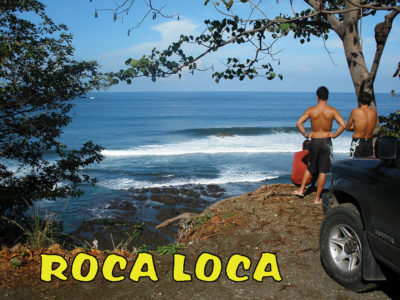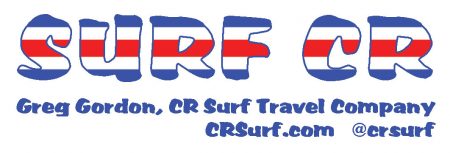The Best Waves in Costa Rica for Advanced Surfers
The Labyrinth
On the way to Ollies Point, you pass this break on the boat. It only starts working when the swell gets to be two feet overhead or bigger. It is predominately a right that has a steep takeoff, followed by a quick barrel if the swell is the right direction, or a racy section where you can maybe fit in a turn or two, and then either clamps shut on the inside or flattens out if you make the shoulder. The rocks on the inside are menacing and knowing that if something goes wrong you are miles from the nearest port can make this spot fearful.
Playa Negra
 A popular right rock-reef break, it is fun when it’s chest to a foot overhead. It’s easy to find the takeoff spot, just look for the dozen guys sitting right on it. But when it gets to be three feet overhead and bigger, the lineup thins out. There is usually a crazy riptide from the swell direction and from the water rushing back out through the shallow inside reef. A second take off spot appears another 30 yards farther outside, so if you are trying for a smaller set you will can easily get caught and walloped by a set wave. But if your timing is right, it is a roll in drop-in with a steep section to carve and then a right round barrel to plow through with a quick exit before you end up on the rock shelf.
A popular right rock-reef break, it is fun when it’s chest to a foot overhead. It’s easy to find the takeoff spot, just look for the dozen guys sitting right on it. But when it gets to be three feet overhead and bigger, the lineup thins out. There is usually a crazy riptide from the swell direction and from the water rushing back out through the shallow inside reef. A second take off spot appears another 30 yards farther outside, so if you are trying for a smaller set you will can easily get caught and walloped by a set wave. But if your timing is right, it is a roll in drop-in with a steep section to carve and then a right round barrel to plow through with a quick exit before you end up on the rock shelf.
Roca Loca
This spot is found half way between Jaco and Playa Hermosa. It is best when it’s double to triple overhead and usually there is not anyone out, or maybe just a few charging locals. The hardest part is paddling out, as there is a steep climb down from a parking spot known for breakins. Then you have to find the keyhole through the rock ledge, which is made more difficult at higher tides or when the closeout sets wash out the entire coast. Once you are out, the takeoff spot is clear—just find the ‘crazy rock’ boil and sit on it until the sets come. This wave can break 150 yards with a steep takeoff followed by a long wall—great for big gouges and top turns. Just don’t get behind it or it will swallow you up and getting back out is not easy.
Pavones
This break is well worth the seven hour drive from the San Jose airport. Normally it accommodates all surf levels as the wave has five sections with the one farther inside ridden by longboarding beginners. But with the right South swell it can light up. At the other end of the break, well to the south of the Rio Claro rivermouth, the take-off spot can be almost to the rocks. Sets can be triple overhead (18 to 20 foot faces) and if you sitting in the right place the takeoff is not too steep. Then you are in for the ride of your life—long racy walls, barrel sections, sections for cutbacks, air sections, and it can keep going for over 1000 yards—all the way past the fishing boats.
Matapalo
Across the Golfo Dulce from Pavones on the tip of the Osa Peninsula sits this break. On smaller days it can be a fun wave with a sinister rock sitting about 40 yards from the beach and right in the way of a good right line. Either you go around it or hop off just before it. But the rock is not an issue when the swell rises above double overhead and it under five feet of extra swell. Timing your paddle out is key or you have to battle the rip for thirty minutes trying to get back to the peak. Also the bowling ball sized white washed rocks on the beach will also thrash you and your board if you mistime your initial descent to the water. Some surfers take a boat from Pavones so that is not a problem at the outset, but if you get caught on the inside then watch out. The bombs can be ridden 200 yards and many times will throw a night barrel.
Salsa Brava
This break is a proving ground for the surfers of the Caribbean Coast. It doesn’t break until the swell is overhead, and then on those smaller days it is most dangerous as the reef is shallow and super sharp. One saving grace is the paddle out from the shore is relatively easy as the back wash winds its way through the deeper channels in the reef and you can follow that. Getting in a little trickier since you have to find those same channels and the alternative is a quarter mile paddle around the other end of the reef. When it gets to be double overhead and bigger, the paddle out is more tense as sets can push you out of the channel and up onto the reef. There are two take off spots, the one farther north has a roll in drop and you are farther out on the shoulder. This is the easier place to sit and if you make the drop can get a quick barrel and a turn or two before it flattens out. The main take off spot is more territorial with the locals, and you can get a deep barrel dropping in left or right. Luck is key as eight of ten waves in each set are closeouts.
Isla Uvita
About a mile off the coast of Limon on the Caribbean side is a wave that breaks as good as any in southeast Asia when there is swell. Is it found on the southeast side of the island, and the shallow reef there bends in a way that makes the wave stand up and throw sick pits. You can only get there by boat or if you have paddling arms like Laird Hamilton. It starts working when the surf is overhead and can handle just about any size swell. The key is to look for a nasty Northeaster, a winter storm that rolls off the east coast of the United States, and wait nine days for winds of that storm to kick up the swell. Since it can be easy to predict when that swell arrives, expect a heavy crew of locals to push the threshold of where it’s safe to drop in.
Why some spots did not make the list—There are over 100 known surf spots in Costa Rica. Some really light up when the swell is big, like Ollie’s Point, Pan Dulce, and Cabuya, but the size is not that big and the crowd would just be aggravating to advanced surfers. Others are amazing up to a certain size like Dominical and Avellanas, but if the swell gets too big then they just close out and there are better breaks close by to discover. And a few others I did not mention since they are closely guarded secrets by the local surf crew. An advanced surfer’s greatest thrill is to roll up to a spot and find almost no one out on the peak. Costa Rica is a country that still has those breaks, and will continue to be a dream destination for all levels of surfers. You want to find those waves, send me a note to [email protected].

